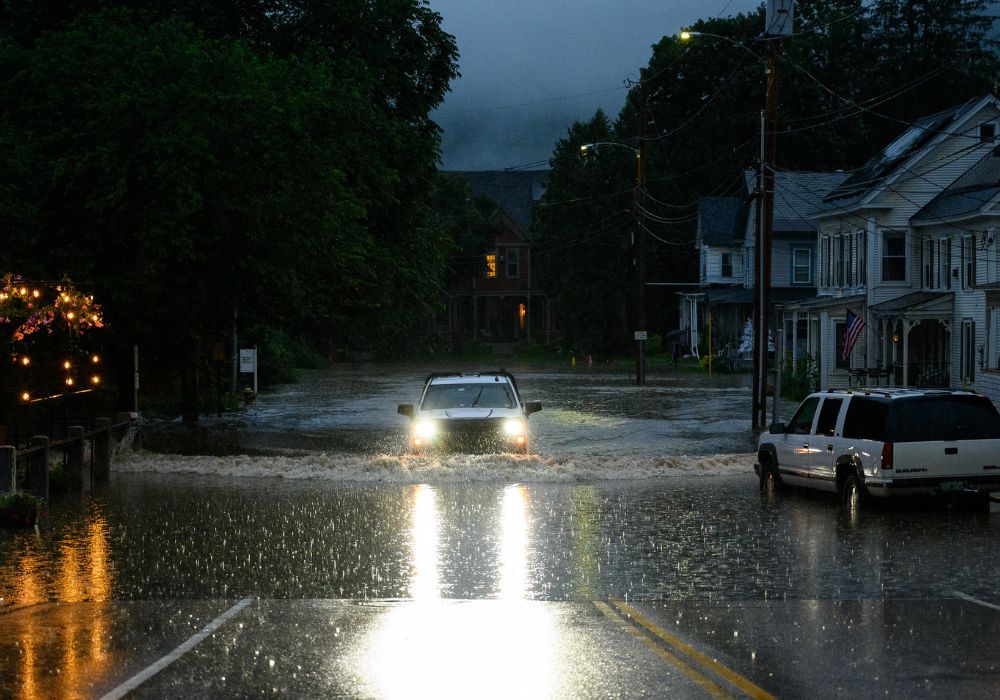Last July, heavy storms lashed Vermont with record rain, leaving roads torn asunder, communities submerged, and farms washed out. In response, state legislators made a historic move by introducing the Climate Superfund Act to hold Big Oil accountable for the damages spurred by the emissions generated by the extraction and combustion of its products.
The bill has finally wound its way through the legislature, backed by tremendous support in both chambers. It now heads to Republican Governor Phil Scott for his signature, which he has suggested he will not provide. But with two-thirds of the House of Representatives and 26 of 30 Senators supporting the law, the Vermont General Assembly could achieve an easy override should the governor choose to exercise his right to veto. Once the bill takes effect, Vermont will be the first state to make Big Oil pay for the impacts of climate disasters.
“The sad truth is we have had multiple devastating climate events in the past year leading up to the legislative session that really drove home the need for this kind of action with Vermont legislators,” said Ben Edgerly Walsh, who helped champion the bill as the climate and energy program director at the nonprofit Vermont Public Interest Research Group. Politicians of every description received the message of the moment, giving the bill strong support across the state’s Democratic, Republican, and Progressive parties.
The law, which faces an almost certain legal challenge, builds on the polluter-pays principle that guides existing hazardous waste remediation laws, and it will mandate that the largest extractors and refiners of fossil fuels contribute — with amounts relative to the emissions they expelled between 1995 and 2025 — to a fund established by the state treasurer. This Climate Superfund will have a two-fold goal: recoup the costs incurred in responding to and recovering from climate-amplified disasters, and dedicate revenues toward resilient infrastructure better equipped to withstand the storms to come.
Once the bill becomes law, a lot of work remains before Vermont sees even a cent. The biggest task falls on the scientists and government officials who will have to determine what big oil companies must pay into the fund and how much they owe. Attribution science provides the backbone for these calculations and for the Climate Superfund Act as a whole by building quantitative links between extreme weather and the emissions of major polluters. By running models that compare scenarios with and without human-induced greenhouse gas emissions, scientists can determine the degree to which climate change shaped a given bout of extreme weather. This method provides a robust basis for calculating the so-called social cost of carbon, and the financial responsibility of major emitters.
“Obviously, this is about these companies paying their fair share, not more than that,” said Edgerly Walsh. “We know that in any world, Vermonters are going to wind up paying significantly for the climate crisis, but these companies should pay their fair proportional share of these costs.”
The Environmental Protection Agency currently places the social cost of carbon at $190 per ton, a rate that Vermont’s treasurer can use to calculate how much fossil fuel companies owe the state based on what they’ve emitted. The money is certainly needed. A 2021 report projected that flooding alone could cost Vermont $5.2 billion over the course of the century. Already, the state has spent more per capita on climate disasters than all but four other states, according to the Vermont Atlas of Disaster.
To determine which businesses to levy the costs upon, the bill outlines a “nexus” of association with Vermont. Any fossil fuel company that has conducted business — such as marketing or selling their gas or coal products — in the Green Mountain State can be subject to the law. But the bill sets a high threshold for inclusion by targeting companies responsible for 1 billion metric tons or more of greenhouse gas emissions. This selective approach ensures that accountability falls on the worst offenders, those who have pumped excessive emissions in the atmosphere since the first United Nations climate conference in 1995. But trying to get the biggest fish on the hook in this way also comes with the greatest risk, and this bill will doubtless face legal pushback.
“The Vermont legislature has understood from the get-go that the fossil fuel industry would very likely use all the tools at its disposal to shirk accountability,” said Anthony Iarrapino, a lawyer who was consulted on the legal framework of the bill. The precedent set by other superfund laws and the expertise behind the scientific testimony have, according to Iarrapino, made the legislation robust enough to withstand challenge in the courts. “They have been very thorough in their analysis,” he said. The attribution method outlined within the bill is also understood to be quite conservative and will almost certainly underestimate how much Big Oil owes, which should further defend the law from claims of excessive burden.
Should the bill survive the legal challenges as expected, Vermont will be the first state in the nation to force Big Oil to pay for the climate disasters caused by its products, succeeding where New York, Maryland, and Massachusetts haven’t. Each has introduced similar legislation, but their efforts have stalled or failed. Last month, however, California joined the mix, introducing its own superfund bill that is currently maneuvering through committees. Such bills demonstrate how states and the nation can conjure creative solutions to the challenges ahead — including the ever-salient question: how to make polluters pay.
Correction: This story has been updated to reflect the EPA’s latest estimate of the social cost of carbon at $190 per ton.
This article originally appeared in Grist. Read the original story here.
Grist is a nonprofit, independent media organization dedicated to telling stories of climate solutions and a just future.







